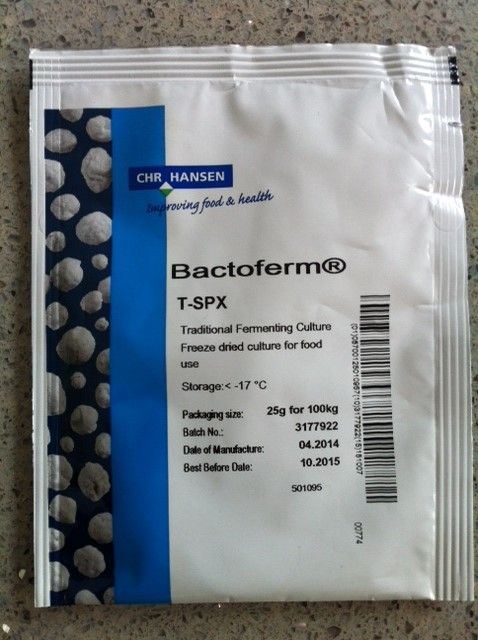Hi Divey,
Yup, pork "butt" is shoulder. It got its name "butt" in Colonial Boston where butchers packed pork shoulder into casks called "butts".
In any semi-dried or dry cured sausage, there is always a risk of fat going sour because it cannot be "cured" by sodium nitrite. This is the reason jerky does not contain large streaks of fat. Of course it is impossible to remove every trace of fat in meat, so we just remove as much as possible in dried products such as jerky. However, if you wish to add fat, it would surely be pork fat because of the flavor profile.
In North America, there are five known species of
Trichinella. They are
Trichinella spiralis, T. nativa, T. pseudospiralis, Trichinella T-5, and Trichinella T-6. The one we deal with most often in pork is
trichinella spiralis. The other four occur mostly in game animals. Species
T-5 is found mostly in bears and other wildlife in the eastern United States, while species
T-6 is mostly in bears and other wildlife in the Northwestern United States. Species
T. nativa is found in Alaska. Both
T. nativa and
Trichinella T-6 are
resistant to freezing.
Trichinella pseudospiralis has been reported infrequently from birds, but can infect pigs also.

You would be surprised at just how many people believe that simple freezing will destroy
trichinella spiralis. Actually, the majority of people believe it, and that frightens me. I often think of the folks who shoot javelinas and think simply freezing the carcass will take care of
trichinella spiralis. It absolutely will not! In fact, The Division of Infectious Disease, Department of Medicine, at Massachusetts General Hospital has concluded that
"Smoking, salting, or drying meat are not reliable methods of killing the organism that causes this infection". Further, "Only freezing at subzero temperatures (Fahrenheit) for 3 to 4 weeks will kill the organism". If folks ever gazed into a microscope and saw the round nematode worm embedded far into human muscle tissue, they would surely think twice about proper sub-zero temperatures. The first time I saw the living microorganism beneath the microscope, I thought I'd lose my lunch! The thing that alarms me is that most people do not have the means of freezing meat at these cryogenic temperatures - so, they take the chance. Yet, if the pork has come from a reliable grocer rather than an "independent small farmer", you will be pretty much safe.
'Wanna get' really scared? Here's how the little buggers work: Trichinella
cysts break open in the intestines and grow into adult roundworms whenever a person eats meat from an infected animal. These roundworms produce other worms that move through the stomach wall and into the bloodstream. From here, the organisms tend to invade muscle tissues, including the heart and diaphragm, lungs and brain. At this point,
trichinosis becomes most painful.
But we can get rid of it right?
Wrong!

The medications
Mebendazole or
albendazole may be used to treat infections in the intestines, but once the larvae have invaded the muscles, there is no specific treatment for
trichinosis and the cysts remain viable for years. Complications of the disease include encephalitis, heart arrhythmias, myocarditis, (inflammation), and complete heart failure. Pneumonia is also a common complication. So, what do we do? Purchase pork from a known, reliable, supplier who conform to USDA and FSIS rules and imports commercially-grown pork. Or, you can cryogenically treat your own if you are a small producer of hogs and insist on feeding your piggies the entrails of other animals.
USDA (FSIS) Regulations Regarding The Destruction of Trichinella Spiralis
The Meat Inspection Division of the United States Department Of Agriculture arranges the size, volume, and weight of meat products into"groups" to specify handling instructions. Meat from hogs, having safely passed these specific requirements, is called
"certified pork".
Group 1 "comprises meat products not exceeding 6" (inches) in thickness, or arranged on separate racks with the layers not exceeding 6" in depth, or stored in crates or boxes not exceeding 6" in depth, or stored as solidly frozen blocks not exceeding 6" in thickness".
Group 2 "comprises products in pieces, layers, or within containers, the thickness of which exceeds 6" but not 27" and products in containers including tierces, barrels, kegs, and cartons, having a thickness not exceeding 27". The product undergoing such refrigeration or the containers thereof shall be spaced while in the freezer to insure a free circulation of air between the pieces of meat, layers, blocks, boxes, barrels, and tierces, in order that the temperature of the meat throughout will be promptly reduced to not higher than 5 degrees F., -10 degrees F., or -20 degrees F., as the case may be".
Item 1: Heating & Cooking
"All parts of the pork muscle tissue shall be heated to a temperature of not less than 138° F." Whenever cooking a product in water, the entire product must be submerged for the heat to distribute entirely throughout the meat. Always test the largest pieces since it always takes longer to reach the 138°F temperature in thicker pieces. Always test the temperature in a number of places.
Item 2: Refrigerating & Freezing
"At any stage of preparation and after preparatory chilling to a temperature of not above 40° F., or preparatory freezing, all parts of the muscle tissue of pork or product containing such tissue shall be subjected continuously to a temperature not higher than one of these specified in Table 1, the duration of such refrigeration at the specified temperature being dependent on the thickness of the meat or inside dimensions of the container."
Table 1: Required Period Of Freezing At Temperature Indicated
Temperature:
Group 1 (first number of days) -
Group 2 (second number of days)
+05° F. 20 days /
30 days
-10° F. 10 days /
20 days
-20° F. 6 days /
12 days
Item 3: Curing Sausage
"Sausage may be stuffed in animal casings, hydrocellulose casings, or cloth bags. During any stage of treating the sausage for the destruction of live trichinae, these coverings shall not be coated with paraffin or like substance, nor shall any sausage be washed during any prescribed period of drying. In preparation of sausage, one of the following methods may be used:
Method No. 1:
"The meat shall be ground or chopped into pieces not exceeding 3/4" in diameter. A dry-curing mixture containing not less than 3-1/3 lbs. of salt to each hundredweight of the unstuffed sausage shall be thoroughly mixed with the ground or chopped meat. After being stuffed, sausage having a diameter not exceeding 3-1/2" measured at the time of stuffing, shall be held in a drying room not less than 20 days at a temperature not lower than 45 degrees F., except that in sausage of the variety known as pepperoni; if in casing and not exceeding 1-3/8" in diameter at the time of stuffing, the period of drying may be reduced to 15 days. In no case, however, shall the sausage be released from the drying room in less than 25 days from the time the curing materials are added, except that the sausage of the variety known as pepperoni, if in casings not exceeding the size specified, may be released at the expiration of 20 days from the time the curing materials are added. Sausage in casings exceeding 3-1/2" but not exceeding 4" in diameter at the time of stuffing shall be held in a drying room not less than 35 days at a temperature not lower than 45 degrees F., and in no case shall the sausage be released from the drying room in less than 40 days from the time the curing materials are added to the meat.
Method No. 2:
"The meat shall be ground or chopped into pieces not exceeding 3/4" in diameter. A dry-curing mixture containing no less than 3-1/3 lbs. of salt to each hundredweight of the unstuffed sausage shall be thoroughly mixed with the ground or chopped meat. After being stuffed, the sausage having a diameter not exceeding 3-1/2" measured at the time of stuffing, shall be smoked not less than 40 hours at a temperature of not lower than 80 degrees F. and finally held in a drying room not less than 10 days at a temperature not lower than 45 degrees F. In no case, however, shall the sausage be released from the drying room in fewer than 18 days from the time the curing materials are added to the meat. Sausage exceeding 3-1/2", but not exceeding 4" in diameter at the time of stuffing, shall be held in a drying room following the smoking as above indicated, not less than 25 days at a termperature not lower than 45 degrees F., and in no case shall the sausage be released from the drying room in less than 33 days from the time the curing materials are added to the meat.
Best Wishes,
Chuckwagon







